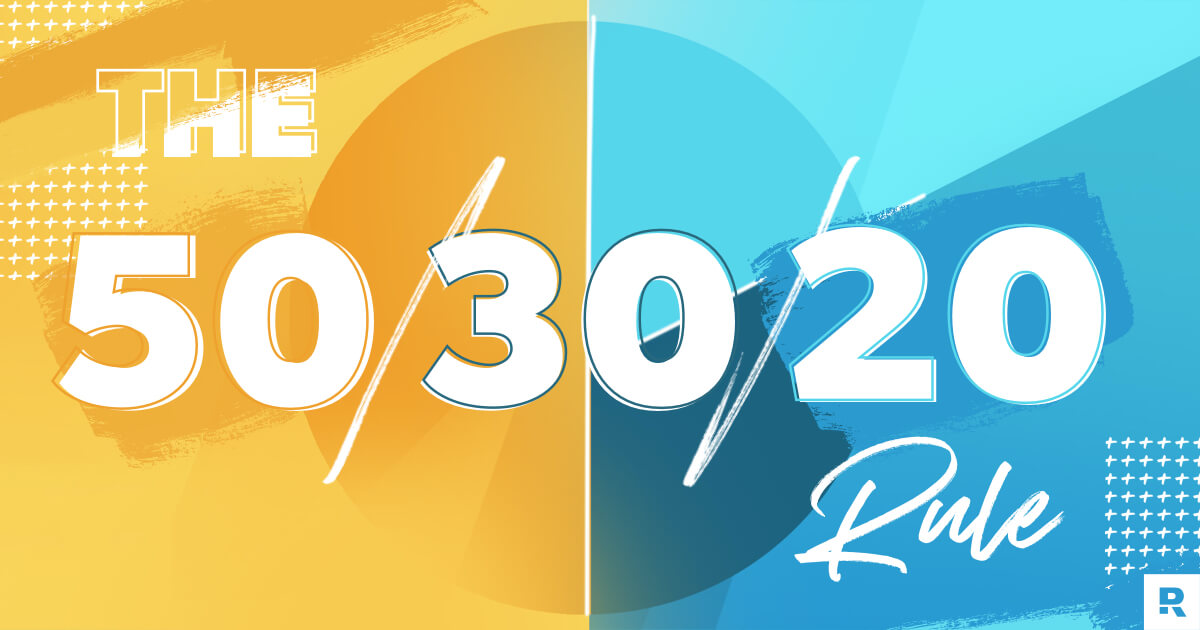The 50/30/20 Budget Rule Explained
9 Min Read | Dec 30, 2024

Key Takeaways
- The 50/30/20 rule is a budgeting method where you divide your monthly after-tax income into three categories: needs (50%), wants (30%) and savings (20%).
- While the 50/30/20 rule prioritizes needs before wants and encourages you to save, it’s not realistic for the average American.
- The zero-based budget is a better method because it helps you customize your budget to your specific expenses and money goals.
Okay, so you want to start budgeting. That’s great! But with so many budgeting methods out there, which one do you go with?
One popular way to budget is the 50/30/20 rule, where you divide your spending and saving into three categories: 50% to needs, 30% to wants and 20% to savings.
But is the 50/30/20 rule a helpful, or even realistic, way to budget? Let’s talk about how this method works—so you can create a budget that best works for you.
What Is the 50/30/20 Rule?
The 50/30/20 rule is a budgeting method where you divide your monthly after-tax income into three categories: needs (50%), wants (30%) and savings (20%).
50%: Needs
According to the 50/30/20 rule, you put half of your after-tax income toward your needs. Now, needs are all the bills and other monthly expenses you have to pay—the things that would majorly affect your life if you dropped them.
Here are some examples of needs:
- Food
- Utilities (electricity, water, natural gas)
- Shelter (rent or mortgage payments)
- Transportation (car payments and gas)
- Insurance
- Health care
- Day care
- Minimum debt payments
30%: Wants
The 50/30/20 rule says to spend 30% of your take-home pay on your wants—or the stuff that improves your standard of living.
But hear me when I say this: Wants are not needs. Yes, we all know this . . . in theory. But when you start dividing all your expenses into categories, the lines between needs vs. wants can get real blurred.
Some examples of wants include:
- Unlimited data plans
- Restaurants
- New clothes or accessories
- Sporting events
- Concert tickets
- Streaming services
- Self-care services (like massages or getting your hair or nails done)
- Vacations or nonessential travel
- New tech
These are all expenses you can technically do without (even if it’s uncomfortable). Because you don’t have to go out to eat when you’ve got groceries in the fridge. And unless your kid outgrew their jacket and school shoes, you don’t need to buy new clothes every month.
20%: Savings
With the 50/30/20 rule, the goal is to put 20% of your monthly income toward savings.
Here are some examples of what’s included in the savings category:
- Emergency fund savings
- Retirement investments
- Down payment for a house
- Sinking funds for car repairs, trips, Christmas, etc.
- Any extra debt payments above those minimum payments
That’s just 20% of your income to get you feeling safe and secure with money for today, tomorrow and down the line in retirement. And with this rule, you’re somehow supposed to save for all of that at once.
The Best Budgeting App!
Get EveryDollar: the free app that makes creating—and keeping—a budget simple. (Yes, please.)
50/30/20 Budget Example
What does it look like to create a budget with the 50/30/20 rule? Well, let’s say your gross monthly income is $6,360. But after taxes and benefit deductions, you take home about $5,000 each month.
If you use the 50/30/20 method to budget, you’d have $2,500 for your needs (50%), $1,500 for your wants (30%), and $1,000 for your savings (20%).
Makes sense on paper. But is that actually enough to cover all your necessary expenses for the month? Should you really be spending that much on your wants, instead of building your savings? And what if you’ve got a massive pile of student loans you’re trying to pay off?
You can probably tell by now that I have some problems with this rule. So, let’s get into the pros and cons.
Pros and Cons of the 50/30/20 Rule
Pros
- It helps you make a plan for your money.
- It prioritizes needs before wants.
- It encourages you to save money.
Cons
- It’s not realistic for most budgeters.
- It doesn’t prioritize saving over wants.
- It doesn’t help you pay off debt faster.
A benefit of the 50/30/20 rule is that it gets you to budget and save—both of which are super important! But while recommended budget percentages can be a good starting point, the 50/30/20 rule ultimately falls short. Here are a few reasons why.
It’s not realistic for most budgeters.
The truth is: The 50/30/20 rule doesn’t work for the average American. In fact, most people’s needs are more than 50% of their income.
Seriously, look at this math:
- The median household annual income is $80,610.1
- The average monthly take-home pay per household (after taxes, Social Security and Medicare come out) is roughly $5,406.2
- According to the 50/30/20 rule, you would budget no more than $2,703 (that’s 50%) for your needs.
- But according to the average monthly expenses, most households spend about $4,500 just on their needs (housing, food, transportation and health care).
That’s over 80% of the average income that goes just to monthly needs. Now, you could find ways to lower those expenses (and you should). But my point is that it usually takes more than 50% of the average income for most American households to operate.
And that’s not even including debt payments! If you’ve got a car loan, credit cards or student loans to pay off, then you probably don’t have 30% left for fun and 20% for savings. When you put the 50/30/20 rule to the test, well . . . that math doesn’t add up! Literally.
Here's A Tip
Use our free budget calculator and see how much it really takes to cover all your monthly expenses.
Also, the 50/30/20 budget rule requires you to fit your money into those same budget percentages every single month. And I don’t know about you, but my budget is never the same each month. Forcing yourself to stick to exactly these percentages isn’t helpful. You need a budget that works with you—not against you.
It doesn’t prioritize saving over wants.
With the 50/30/20 rule, you budget 30% for your wants and put 20% toward savings. Yes, saving 20% is better than saving nothing at all. But that’s not the best (or fastest) way to build your savings.
Savings should be a priority—not an afterthought. Especially if you’re saving up for your emergency fund or for a big goal, like a down payment on a house. The 50/30/20 rule makes it easy to put savings on the back burner, when it should be one of the very first things you budget for each month.
It doesn’t help you pay off debt faster.
With the 50/30/20 rule, you’re paying off your debt . . . but slowly. It combines both saving and extra debt payments to make up only 20% of your overall budget. That’s not enough if you really want to make a dent in your debt!
And if you’ve got debt, you shouldn’t be spending 30% of your money on things you don’t need anyway. You should be focusing on knocking out your debt as fast as you can. That means cutting back on extra costs (aka the wants) so you can throw more at your debt and take back control of your income.
Plus, trying to hit too many major money goals at once can actually keep you from making progress. You’re much better off if you line up your big money goals in order of priority (using the 7 Baby Steps to guide you) and knock them down one by one. You’ll be able to really focus as you save for emergencies, pay off debt, and build your retirement savings—in that order.
And when your budget is set up to help you take those steps one at a time, you know what happens? You. Make. Progress. Faster. And that’s what I want for you—to make progress with your money!
Your budget should live and breathe with you. It should adapt to your stage of life and to your money goals. The 50/30/20 rule just doesn’t do that.
The 50/30/20 Rule vs. the Zero-Based Budget
The 50/30/20 rule boxes you in. But budgets aren’t one-size-fits-all. Your budget should reflect your reality. It should reflect where you are right now and where you want to be with your money—not force your expenses into some blanket percentage category.
What you really need is a zero-based budget. What’s that?
A zero-based budget is when your income minus your expenses equals zero. You give every dollar a job and make every part of your paycheck work for you and your goals!
When you budget, start with giving, next saving, and then needs (what I call the Four Walls—food, utilities, shelter and transportation—and then other essentials). After that, you prioritize everything else in the budget based on your income, your situation and your Baby Step.
The zero-based budget method is better than the 50/30/20 rule because it lets you customize your budget to your specific expenses and money goals. It also helps you make progress faster and intentionally get your spending under control.
Plus, a zero-based budget is way more flexible! As things change in your life, so does your budget.
|
50/30/20 Budget |
Zero-Based Budget |
|
|
|
|
|
|
|
|
Create a Budget That Works for You
Now that you know a zero-based budget is the way to go, let me tell you about my favorite zero-based budgeting app—EveryDollar.
EveryDollar is what I use to budget every single month. It makes it super easy to tell your money where to go, customize your budget categories, and track your monthly expenses (needs, wants, savings and all). Plus, it’s free!
Stop trying to cram your life and your goals into percentages that don’t make sense. Go all in with the zero-based method and create a budget that’s gets you closer to your money goals.
50/30/20 Budget FAQ
-
How is money divided using the 50/30/20 method?
-
When using the 50/30/20 budget method, monthly expenses are divided into three categories: 50% to needs, 30% to wants and 20% to savings.
-
Is the 50/30/20 rule after taxes?
-
Yes, you use your monthly after-tax income (take-home pay) when budgeting with the 50/30/20 rule.
-
When might the 50/30/20 rule not be the best saving strategy to use?
-
If you’ve got a specific savings goal (like building an emergency fund or saving for a home down payment), the 50/30/20 rule won’t help you make progress as fast as the zero-based budget method.
-
When using the 50/30/20 rule to budget, what category are loan payments in?
-
When using the 50/30/20 rule, minimum debt payments are budgeted under needs (50%) and any debt payments above the minimum are budgeted under savings (20%).
-
Does the 50/30/20 rule include 401(k) contributions?
-
Yes, the 50/30/20 rule includes 401(k) contributions in the savings category (20%). But if your employer automatically deducts your 401(k) contributions from your paycheck, you’d need to factor that in when budgeting your take-home pay.
-
Can I modify the percentages in the 50/30/20 rule to fit my circumstances?
-
You can technically adjust the percentages in the 50/30/20 budget to fit your specific situation. But at that point, you’re not really budgeting with the 50/30/20 rule—you’re doing your own thing. That said, you’re better off using another method, like the zero-based budget, to create a budget that works for your specific expenses and current money goals.


